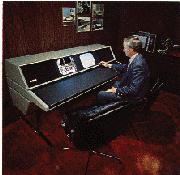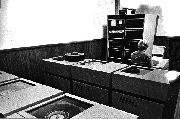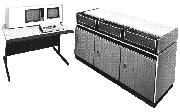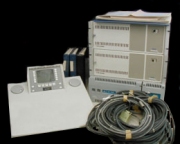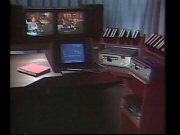|
|
|
|||||||||||
|
The first video tape recorders were operated by technicians and engineers, who had no experience in the creative side of editing. All the creative editors of course came from film. So it was natural that some form of "offline" editing be developed.
What follows are the descriptions of four early offline techniques. They're
are many, many more than just these...
One of the most popular shows of its day was NBC's "Laugh-In" (1968 - 1973). This show was recorded and conformed on two inch tape, but edited on film. This was done before the advent of Time Code or electronic editing. During taping, "Editor Sync Guide" (ESG) was recorded on the second audio channel. ESG consists of two voices counting. After taping, the selected takes were transferred to 16-millimeter film, with mag audio, and the ESG. The film and audio tracks were then cut using tradition film techniques.
Once the offline was completed, the video tape editor manually conformed
the video tape, using the Smith splicer, and making his cuts based on the
ESG.
The late Hal Collins was a Hollywood film editor and was also one of the first editors to edit video using film techniques. In this case, the video tape was transferred to film, with the time code visualy displayed in the image (ed: poorly). Hal would edit the film and mag tracks. His finished work print would then be transferred back to a master video tape. This master tape would include new, continuous, time code. This new time code would also be visually displayed in the recording. The video editor would then create an editing log showing the times from the work print and the corresponding times on the master tape.
Once this log was finished, the editor would then electronically replace
the work print scenes with the original material.
ABC's "Barney Miller" (1975 - 1982) was another extremely popular show that was shot on video tape, and edited offline. In this case, the editing was done on 1" IVC's, but the process was quite unique. The show was taped with four camera's, each camera fed its own recorder. A fifth camera, also feeding its own recorder, was focused on four TV screens, one for each of the other camera's. In post, the editor first did a cut using the "quad" tape. Once that was done, an assistant editor would replace the quad pictures with the isolated tapes. Once the final work print was ready. The assistant editor would read the time codes off the tape, and using an IBM Model 29 card punch, prepare one card for each edit.
These cards were then read by a conversion program to create a standard
edit decision list on paper tape. This final paper tape was used to
auto assemble the show.
They used two IVC-870 1" VTR's and one of those large, black darkroom timers. The tapes would be manually parked 10-seconds before the edit point, and the timer would be set to 10-seconds. Then with one switch, the two VTR's would be placed in play, and the timer started. When the timer reached zero, it would trigger the Edit.
This system worked very well, and was used to produce a full season of
shows.
But the 600 was really ahead of the available technology and it suffered from several short comings. First it was very expensive (about $250,000 per system), second only a very few were built (6), third, at the most, it could store about 27-minutes of a very poor quality black and white video. Despite its short comings, it was used to edit a number of shows and commercials, and it first demonstrated those concepts that are just now being realized in today's non-linear editors. More on the 600
|

